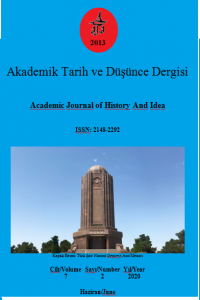XX. Yüzyılın ilk Yarısında Güney Kafkasya'ya Ermeni Göçleri
Farklı ülkelerden bilim adamlarının araştırmalarına ve Çarlık Rusya'sının arşiv belgelerine atıfta bulunan makalenin amacı, Ermenilerin Güney Kafkasya'nın yerli halkı olmadığını göstermektir. Jeopolitik çıkarlarını güvence altına almak için çeşitli güçler tarafından bölgeye taşındılar. Ermenilerin Güney Kafkasya'ya yeniden yerleştirilmesi yüzyıllar boyunca kademeli olarak gerçekleşti. Sadece XIX yüzyılın 20-30'larında Rus İmparatorluğu, bilinen olaylardan sonra 200 binden fazla Ermeniyi Güney Kafkasya'ya yerleştirdi. Kırım Savaşı ve sonrasındaki olaylar sonucunda 10 bin Ermeni belirtilen bölgeye kaçtı. 1. Rus Devrimi sırasında Ermeni terör örgütleri Rusların desteğiyle bölgeye çok sayıda Ermeni göçmen yerleştirdi. Makalenin başlığından da anlaşılacağı üzere çalışmanın özünü ortaya çıkarmak için karşılaştırmalı-tarihsel, veri analizi, tarihsel-betimleyici yöntemlerin kullanıldığı ortaya çıkmaktadır. Tarihsel karşılaştırmalı yöntem, kaçınılmaz olduğu için bu makalenin oluşumunda başı çekmektedir.
Anahtar Kelimeler:
Güney Kafkasya, tehcir, Ermeni göçleri, geri dönüş, göçmen, mülteci, terör, katliam
Armenian Migrations to South Caucasus in the first half of XX century
The purpose of the article, concerning the research of scholars from different countries and archival documents of Tsarist Russia, is to show that the Armenians are not the aboriginal population of the South Caucasus. They were moved to the region by various powers to secure their geopolitical interests. The resettlement of Armenians to the South Caucasus took place gradually over the centuries. In the 20-the 30s of the XIX century alone, the Russian Empire, after the well-known events, resettled more than 200 thousand Armenians to the South Caucasus. As a result of the Crimean War and subsequent events, 10 thousand Armenians fled to the specified region. During the 1st Russian Revolution, Armenian terrorist organizations, with the support of the Russians, settled numerous Armenian emigrants in the region. As seen from the title of the article, it turns out that comparative-historical, data analysis, historical-descriptive methods have been used here to reveal the essence of the study. The Historical-comparative method is the leading one in the formation of this article, as it is inevitable.
Keywords:
: South Caucasus, deportation, Armenian migrations, repatriation, migrant, refugee, terror, massacre,
___
- Georgian Central Most Recent History Archive (GCMRA) f. 600, pol, 2, Geo.21.
- Georgian Central Most Recent History Archive (GCMRA) f. 607, pol, 1, Geo.2269.
- Georgian Central Most Recent History Archive (GCMRA) f. 607, pol, 1, Geo.327.
- Georgian Central Most Recent History Archive (GCMRA) f. 612, pol, 1, Geo.27.
- Georgian Central Most Recent History Archive (GCMRA) f. 617, pol, 1, Geo.506.
- Georgian Central Most Recent History Archive (GCMRA) f. 617, pol, 1, Geo.168.
- Russian State History Archive (RSHA) f.1083, pol, 1, works 26.
- Russian State Military-History Archive (RSMHA) f. 1300, pol, 19, works 313.
- Crimes of Armenian terrorist and Gang units against mankind, XIX-XXI cc, Baku 2003.
- GASIMLI, M., The Armenians’ claims from Sovietization of Armenia until the occupation of Azerbaijan territories: history as it is (1920-1994), Science Development Fund under the President of the Republic of Azerbaijan, Baku 2016.
- GURGUN, K., Armyanskoe dosye, Yazici, Baku 1993.
- MIRZABAYLI, A., The Knot of Kharabakh, Baku 2012.
- SÜSLÜ, A., KIRZIOĞLU, F., YINANZ, R., HALACOĞLU, Y., Türk tarihinde ermeniler (Temel kitap), Ankara 1995.
- Spravka prokurora Ecmiadzinskovo Sinoda A.Frenkelya predstavlennya v 1907 g. Svyateysemu Sinodu //Izvestiya AN Azerbaydjanskovo SSR Seriya istorii, filosofii i prava. 1989, №2. SARKISYAN, G., AKOPYAN, T., ABRAMYAN, A., Istoriya armyanskovo naroda s drevneyshix vremen do nashix dney, Izdvo Erevanskoqo unta, Erevan 1980.
- SHAVROV, N., Novaya ugroza russkomu delu v Zakavkaze: predstoyashya rasprodaja Mugani inorodcam, SPb., 1911.
- TAŞKIRAN, C., Ermeni Diasporası Nedir? Ne İstiyor?/ Ermeni araştırmaları I Türkiye Konqresi bildirileri. C.III, ASAM-EREN, Ankara 2003. TETVADZE, SH., TETVADZE, O., Armyane v Gruzii (s drevnix vremen do sevodnyashevo dnya), Tbilisi 2008.
- Yayın Aralığı: Yılda 6 Sayı
- Başlangıç: 2013
- Yayıncı: Hakan YILMAZ
Sayıdaki Diğer Makaleler
‘Talât Paşa Evrakı’nın Muhtemel Kaynaklarından Birisi
Avrasya Ekonomik Birliği Çerçevesinde İşçi Göçlerin Düzenlenmesi
Uygur Harfli Oğuznamedeki Hayvanlarla Oğuz Kağan’ın İlişkisi
Elvan ESER, Veli Ulaş ASMADİLİ
Antik Yunan ve Roma Dünyasında Fizyonomi: Tarihsel Köken, Bakış Açısı ve Yöntem
Sabir Yaradiciliğinda Təxmis və Təsdis: Poetik Özəllikləri və Struktur Xüsusiyyətləri
Şeyh Galip ve Diğer III. Selim Devri Şairlerinin Beyhan Sultan ve Hatice Sultan İçin Yazdığı Şiirler
Amerika ədəbiyyatinda detektiv janrin əsas ideoloji aspektləri
Erken Tarihte Sosyal ve Kültürel İletişim ve Dinlerin Yükselişi
Gazali’nin Nasayihü’l-Müluk Adlı Eseri ve Eserde Sayıların Kullanımları
